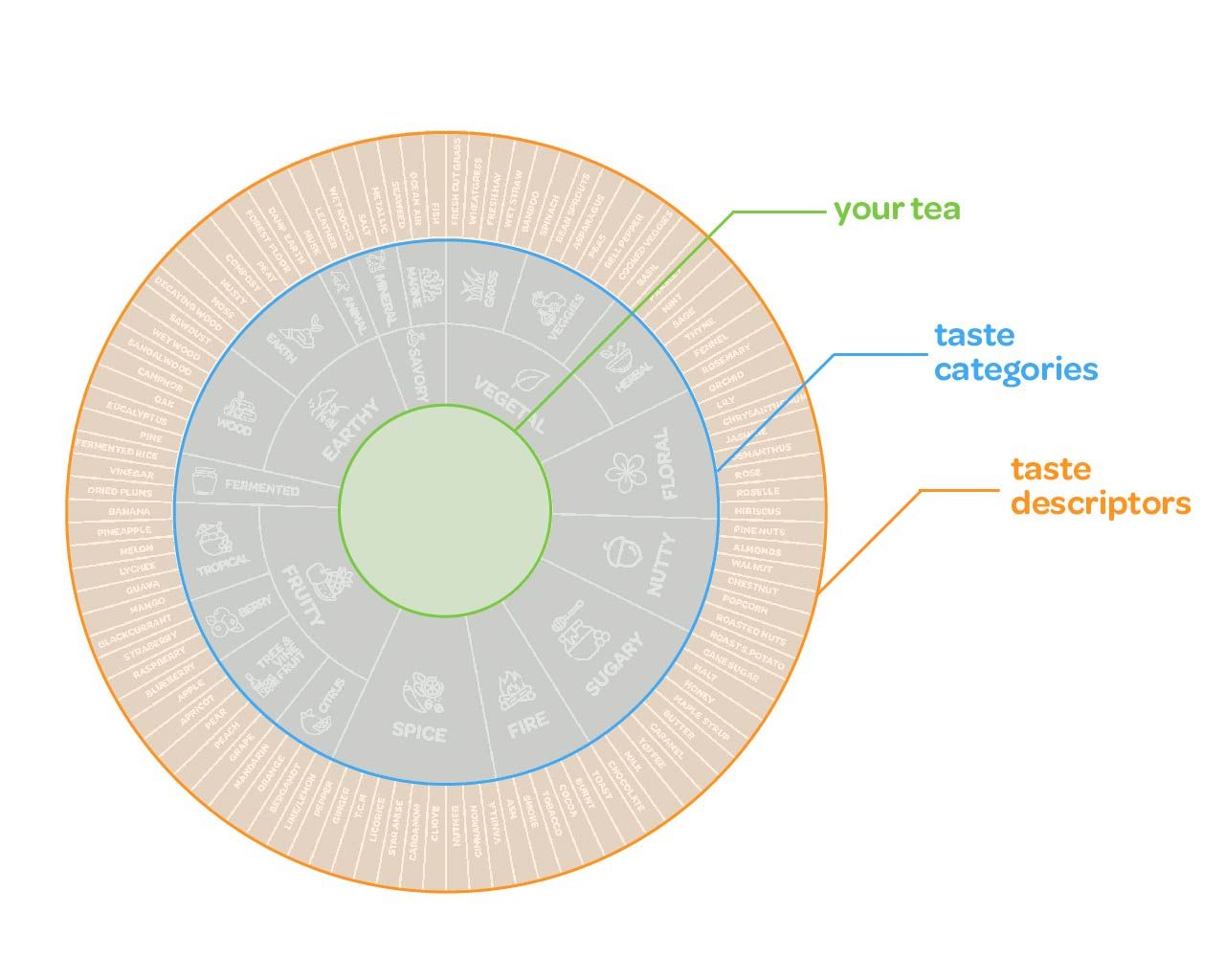Disclaimer: We're not sommeliers, so this is not some professional tasting guide. Rather, these are our learnings as an experience artist working with taste and exploring taste experiences, with (maybe too much) attention and specificity. We hope it tickles your curiosity enough to dive deeper into how you engage with your sense of taste during tea and beyond!
Hello there!
We're going to assume that you found you way here because you've by hook or by crook acquired our A Visual Guide to Tea Flavors: Empori Flavor Wheel, and is wondering, how do I use this thing?
Well, here's quick-start guide on how you can use the humble flavor wheel!
(Note: you can use these tips with all and any flavor wheel, not just ours)
Level 1: Using the flavor wheel as a Taste Dictionary/Thesaurus
You'll notice that the flavor wheel is organized into layers: the outermost layer are the Flavor Descriptors. the middle ring are the Flavor Categories, and the innermost layer is...blank. This blank spot is where your tea goes!
(You don't actually have to PUT the tea there of course)

How you use the flavor wheel to help you find your own flavor descriptors is to work your way outwards.
Step 1
You start with your tea: you drink it and taste it.
Step 2
You then move on to the next layer: Flavor categories.
You must be tasting many things, even if you can't immediately describe them. So now your job is to identify what these flavors are. You can do so by trying to categorize these taste sensations.
Basically, you'll look at the flavor categories and ask yourself: "Do I taste grassy flavors? Roasted flavors?"
Once you've worked your way through the categories and identified the types of flavors you're tasting, you can start getting more specific.
Step 3
Which is when you can move to the outermost ring: Flavor Descriptors.
The obvious thing to do then is to look at the descriptors on outermost ring and see which one best describes the flavor you are tasting.

Level 2: Find Your Own Words
But what happens if nothing in the outer most ring seem to describe what you're drinking... Then what? OR you want to use even more specific taste descriptors that the ones provided?
Then what?
Well, this humble wheel can also help you find YOUR own flavor descriptors.
It does so by helping you pull out your relevant taste memories.
Why are taste memories relevant you ask? Well, it's because most of the time, we describe flavors using foods and objects we've previously encountered.
e.g. "This tea has notes of caramel"
So when you want to find your own words to describe something, you're likely to refer to foods or objects you've previously tasted.
Right, in which case, how can the wheel help you call upon the right memories?
Let's go back to Step 2, looking at Flavor Categories.
Let's say you know the tea has roasted notes, but none of the descriptors on the outer-most ring matches what you're tasting. Then the next thing you can do is to think of all the roasted foods you've had. Maybe it's BBQ meat from Chilis, or your family's Sunday Pot-roast. You can even expand beyond food and into other things, like your friend's favorite brand of cigarettes, or the smell of burning sage you use to cleanse your apartment. Once you've recalled these flavors, compare it to the one you're trying to describe in your tea. Are the flavors you are tasting similar to any of the foods you've recalled?
It's okay if the flavor is not a perfect match for the food.
There's a reason these are called flavor "notes".
The taste/flavor of a tea (or any food or drink for that matter) is like a song which is comprised of many different notes. And just like how songs that share the same notes will sound similar but not exactly the same, foods that share the same flavor notes will also be similar but not the same. So think of taste descriptors as individual notes that make up the song of the tea's flavor, and what you are doing is trying to identify what these notes are.
Once you find a word that you feel sits right with you, you can write it down, either on a piece of paper or an empty flavor wheel!
(That's actually what the empty wheel in the empori flavor wheel pdf is for. We included it so you can you very own taste descriptors and have your own unique flavor wheel!)
So continuing our roasted notes example, maybe the flavor of this tea is similar to the smell of burnt molasses. You can go ahead and write down 'Burnt Molasses' on the outermost ring, under Fire.

But how do I know if the descriptors sits right with me?
You'll just know.
Or that's we'd like to say, but that's not helpful at all.
Honestly, there are no hard and fast rules about determining if a taste descriptor sits right with you.
But we'd like to think that if a taste descriptors is "feels right", it'll give you the same sensation as when you find a puzzle piece that fits. Another way you can tell might be observing whether or not just thinking of that taste descriptor will instantly cause you recall or feel similar sensations as the flavors you are tasting.
But honestly, humans are built to problem solve, we're hard wired to make things match. So we truly believe that when a taste descriptors "clicks", you'll just know. It's innate, instinctive, visceral even.
But if what the taste descriptors that clicks isn't even food flavor?
What if the taste descriptor that fits is something non-food related, like 'battery acid' or 'pen ink'? (We've heard both.)
That's fine. If that's what the flavor tastes like to you, that's what it tastes like to you. Some teas taste like musty cupboard to us, but 'furniture' isn't a flavor category on our flavor wheel (or any of the others we've seen).
And that's okay. A flavor wheel isn't a periodic table, the taste descriptors on them are not absolute. They don't contain the be all end all of flavor descriptors in the world.
All the flavor wheel is supposed to do is to guide you and inspire you to generate more specific taste descriptor that helps YOU conceptualize and remember a flavor.
In fact, even if the taste descriptor that clicks is something completely abstract like "sparkly", or "Powerpuff Girls" (and yes we've heard both from people we did tastings with), they're still completely valid taste descriptors.
Yes, maybe it'll be a bit hard for others to understand what you mean, but you can't begin to explain a flavor to others until it makes sense to you first. Therefore, the most important thing when trying to describe flavors are for the words to make sense and mean something to YOU.
The real question is, where would these unique and curious taste descriptor go on the flavor wheel?
Well that's a discussion for a whole other article.
(Hint hint: it has to do with building your own custom flavor wheel).
For now, you can write these unconventional flavor descriptors on the side or the flavor wheel, or keep a little dictionary of non-food taste descriptors for yourself.
So let's recap
How you can use a flavor wheel:
- Level 1: Use it as taste dictionary/thesaurus
- Level 2: Use it to help you come up with more specific taste descriptors based on your flavor memories.




